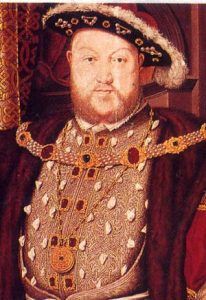
Henry VIII rarely if ever referred to his divorce from Catherine of Aragon as a divorce. Henry preferred the term the ‘great matter’. The ‘great matter’ was to run for six years before it culminated in what Henry had wanted for so long – divorce from Catherine followed by marriage to Anne Boleyn. What surprised so many of those who knew Henry was that he managed to sustain his interest in Anne for so long as he was notorious for having a very short ‘friendship’ span when it came to female relationships. Anne was a very skilled manipulator and she handled Henry well. The rumour that was spread at court was that she had used witchcraft to cast a spell on Henry. Nonsense now, but readily accepted in Tudor times when something that could not be explained by ‘normal’ ways was invariably classed as witchcraft.
There is little doubt that Henry placed huge value on getting a male heir to succeed him. The young Princess Mary was not viewed as being strong enough to rule the country. This was very much the view of women in Tudor times regardless of whether Mary was a princess or not. Henry’s relationship with Mary was also clouded because her mother was Catherine of Aragon – the woman Henry wished to divorce. Henry believed that Catherine was condemned by God not to have a boy and that Anne would provide him with one. This explained his desire for the ‘great matter’ to be concluded. The matter took on an even greater urgency when in January 1533, Anne told Henry that she was pregnant.
It is difficult to know whether Henry truly felt that he had sinned by marrying Catherine. The marriage lasted long enough (1509 to 1527) before Henry talked in terms of an annulment so it would be reasonable to state that his conversion to believing that he had unwittingly sinned only happened when it became convenient for him to demand an annulment because of the fact that it was a sinful marriage. How much his sinful behaviour played on his mind from 1527 to 1533 will never be known but if Henry did believe in the whole idea of sin, it did not stop him chasing after Anne Boleyn nor fathering a son while still married (in the eyes of the Church) to Catherine.
We do not know precisely when the mere marriage annulment ‘matter’ became a much greater issue that culminated in the dissolution of the monasteries. Some historians believe that this started as early as 1531. If this is the case, then Henry had every reason to maintain his desire for a divorce. It is highly likely that the king was greatly motivated in this by the knowledge that if he could get control of the monasteries in England and Wales, his wealth would vastly inflate.
Historians like Keith Randall also point to the fact that the ‘great matter’ was an issue of pride for Henry. Once he had made up his mind, Henry was not willing to back down, especially as such an action would be seen as a sign of weakness. Being the man that he was, Henry would not stop until he had got what he wanted. On the same topic was the fact that Charles V, the Holy Roman Emperor, had spoken out against an annulment – Henry would have been unwilling to come off second best to a major rival in Western Europe. The more public and international the issue became, the more determined Henry was to see it through to its conclusion – but it would be a conclusion that Henry wished for.
What surprised many contemporaries was that Henry stuck to the ‘great matter’ for so long. He was a man whose interest waned very quickly in most things, unless it was sport. For the ‘great matter’ to dominate a whole six years of his life clearly shows that Henry was only willing to get out of it what he wanted and nothing else. That he was willing to take on Clement VII for five years shows just how committed he was. The one curiosity was why he simply did not order the murder of Catherine disguised as a sad and unfortunate death. If this had occurred – and Henry had certainly used it before – Henry would have been free to marry Anne. However, it did not happen though many of Catherine’s friends believed that Henry was planning to do just this. When she died in 1536, it was believed that Catherine had been poisoned on the king’s orders. This was not true and she died, it is thought, of cancer. However, why this was not tried in the six years of the campaign for an annulment is not known. From Henry’s point of view, it would have served a purpose. Perhaps after so many years of marriage he could not contemplate such an action – or perhaps he still felt some affection for a wife who, in fact, had done no wrong.
Related Posts
- Catherine Parr was born around 1512. She was Henry VIII’s sixth and final wife. Catherine had already been married to a man called Lord Borough.…
- Catherine Parr was born around 1512. She was Henry VIII’s sixth and final wife. Catherine had already been married to a man called Lord Borough.…
- Many in England believed that the succession of Henry VIII would usher in a less austere era than the one Henry VII had ruled…
